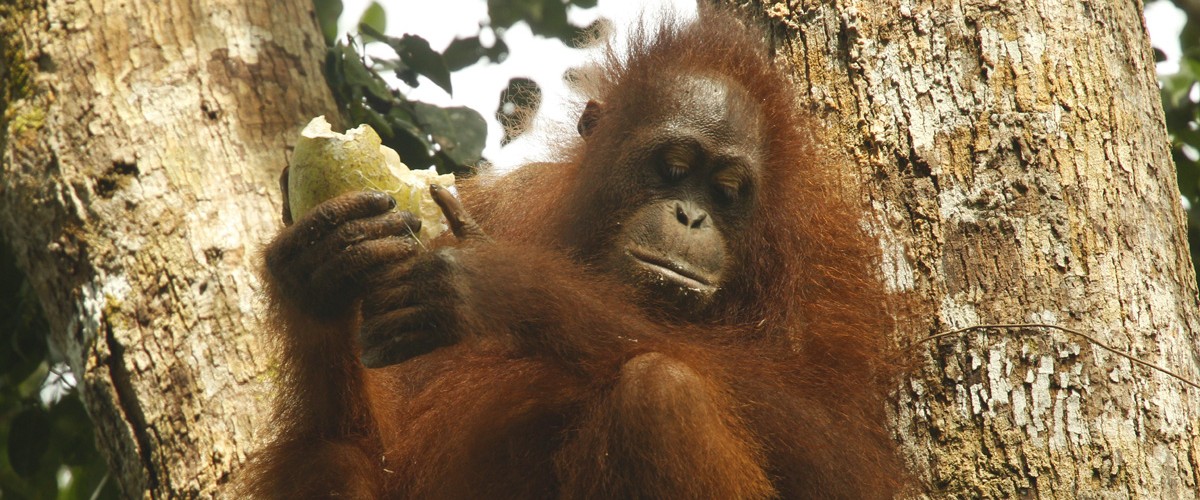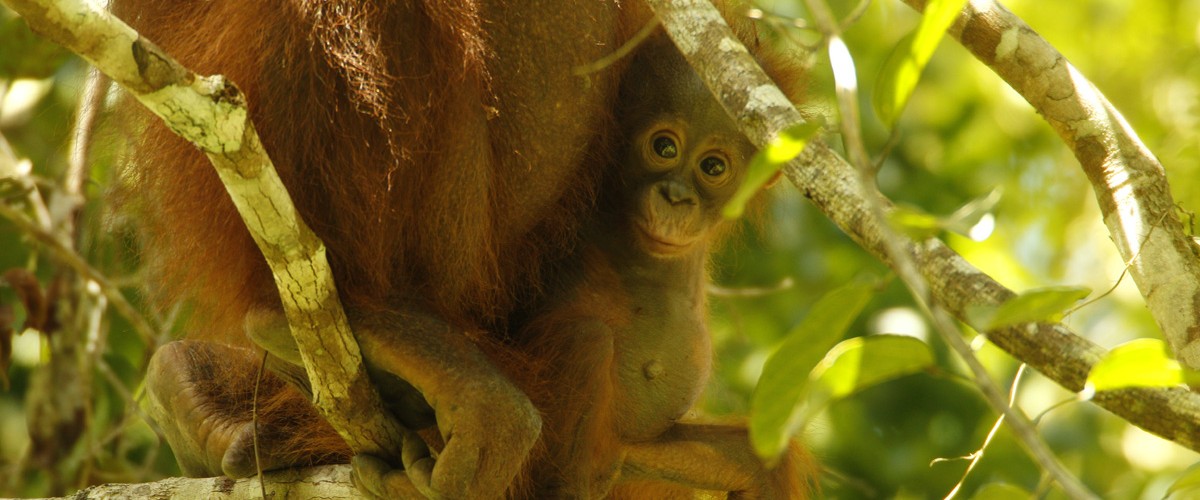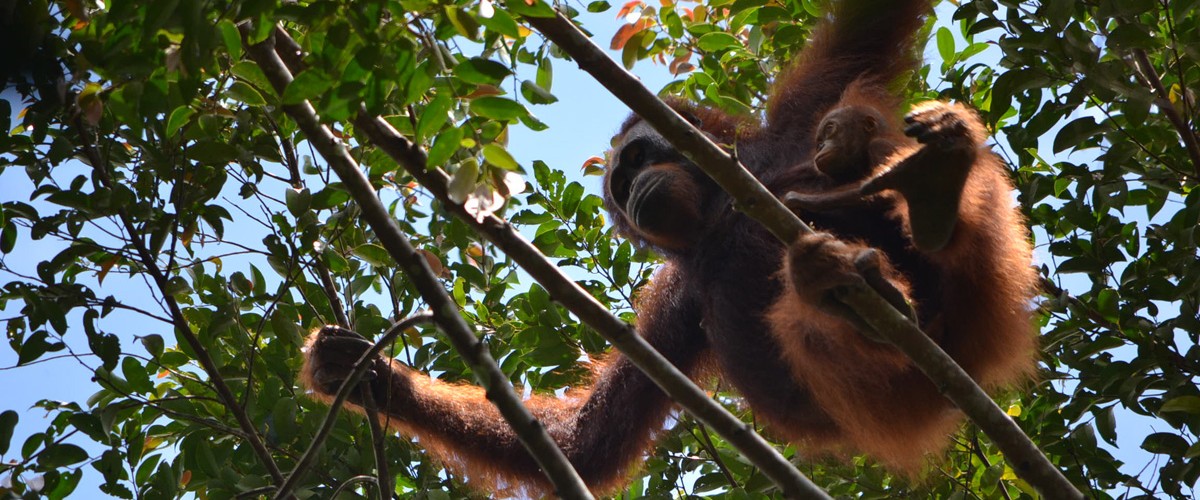By Becky Curtis, GPOCP Assistant Research Manager
Research focused on critically endangered animals always means that new additions to the population are certainly something to celebrate! With that in mind, we would like to take a moment to cheer for our hard working orangutan mothers and their growing clans within our beloved forest! During recent months we have been lucky enough to get to know some young new families… as well as the return of some old faces!
Young orangutan mother, Rossa, was first met by research assistant, Akau, in the dense peat swamps of Gunung Palung National Park. With her young juvenile, Ronnie, not far from her side, she wasn’t used to being followed by our assistants, but the researchers have become accustomed to a busy day scrambling through the forest when following this lively pair. Rossa often encircles our group to closely inspect her mysterious followers, finding a branch where she can clearly observe us while also keeping a close eye on her baby. This pair seems to have won the genetic lottery in terms of attractiveness for orangutans. Both have thick, fluffy red hair covering their bodies and healthy, symmetrical faces. It is ironic that in field research we rejoice in the less-than-perfect individuals; usually the ones with scars, bite marks, deformities or unusual traits are the easiest to identify. When recognizing these wild orangutans, individuality and uniqueness is most definitely celebrated!
 |
| Rossa resting comfortably in the canopy where she can keep an eye on Ronnie and the research assistants. Photo credit Becky Curtis. |
Another older mother – infant pair we have not seen for some time is, Janda Tua and her almost adult daughter, Januari. We hadn’t seen the two since Januari was a tot back in 2011. Meeting them now, nearly six years later, we noticed that Janda Tua has developed a large growth on her right hip. We are not sure what type of growth this is or how harmful it is to her health, but she is an older lady who tends to travel slowly through the treetops and regularly takes a siesta in a day nest. On the other hand, her daughter, Januari, couldn’t be more different. At one point this month, while both Janda Tua and Januari were being followed, the research assistants felt the need for some healthy competition of rock, paper, scissors to see who gets to plod slowly after Janda Tua, or race frantically after the boisterous Januari. Research Manager, Brodie, and I drew the short straws that day and raced after Januari. I was also initiated into taking Ipad data during a follow. I finally understand the challenges of takingbehavioral data mid-follow. You haven’t known multitasking until you are untangling yourself from thorny vines and leaping over logs while trying to keep your eyes on the swaying and rustling branches above, frantically punching codes into an Ipad screen, recording how far right, left, up, down, north or south the orangutan is travelling and with what arms and legs first. Not only this, but Januari is a pretty sneaky character. At one moment during our follow, we stood watching her munching in a fruit tree for some time before she descended from her height, only to disappear.
 |
| Januari hiding in the tree tops. Photo credit Brodie Philp. |
“Can you see her?” Brodie called from the other side of the tree. I was about to reply a confused “no,” before suddenly spotting her beady eyes glistening through the gaps in the leaves in some shrubby trees to my left. Her eyes stayed fixed on us as I saw her place her hands and feet across the branches as gently and delicately as possible. Making no sound whatsoever, the clever little orangutan was trying to give us the slip. The moment she realized her ploy was unsuccessful and we began stepping towards her, she was darting through the trees again, often swinging from branch to branch like a mischievous gibbon. Although almost fully independent, Januari, still regularly meets up with her mother, either to nest in the same tree at the end of the day or for a relaxed afternoon of grooming one another in the late afternoon sun.
We had the pleasure of seeing another family that the research project hadn’t seen for a few years. Research assistant, Toto, found mother, Salju, and her juvenile, Saldo, one morning up in the mountainous regions of Cabang Panti. The pair is easy to identify with their distinctive facial features, very long faces and slanted eyes.
 |
| Saldo snacking on some twigs in the mountainous region of Gunung Palung National Park. Photo credit Becky Curtis. |
We have also had a recent return of some of our project regulars. One of the first orangutans I followed in Gunung Palung National Park in 2016 was mother, Bibi, and infant son, Bayas. Little Bayas is steadily growing and he is endlessly playful and investigating all leaves, twigs and bark with his mouth, and copying his mother’s feeding habits. Although gaining in strength and confidence by climbing on his own, Bayas won’t hesitate to cry at Bibi should she cut a session of breast-feeding a little shorter than he would like. Bibi also has an older, now independent daughter called Berani who, like Januari, rocks up regularly to hang out with her mother. Berani does, however, have to watch out for her mother’s temper. Bibi is defensive of her food sources and we have seen her give Berani warning kiss-squeaks to stay away. After eight years of intense parental care, I suppose a bit of tough love is necessary from orangutan mothers!
With all these mother-infant pairs floating around the place, we do hope to have the cries of new little orangutans soon. Brodie and the research assistants have recently seen some hanky panky between our celebrity orangutan, Walimah, and resident flanged male, Alfred. Since the tragic loss of her young baby last year, Walimah has not become pregnant again, so the idea of a new baby for her is a heart-warming one. So, from now on you can expect us to be running around below Walimah with pregnancy tests and let’s hope that we will have news of another addition to the orangutan families of Gunung Palung!









